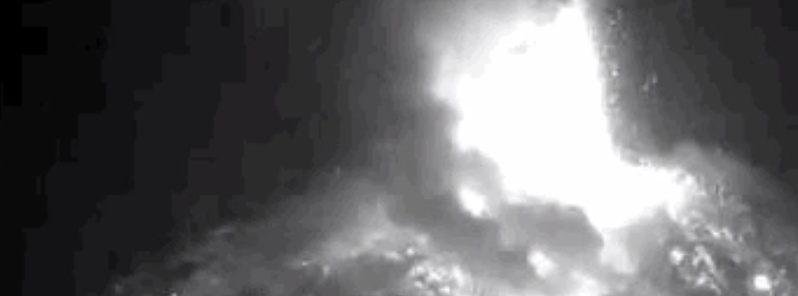Partial dome collapse after explosion at Nevados de Chillan volcano, Chile

A strong explosion was recorded at Chilean Nevados de Chillan volcano early January 11, 2019, resulting in a partial dome-collapse event. The Alert Level remains at Orange.
The explosion took place at 08:00 UTC (05:00 local time), January 11 and was recorded by a webcam. The event was associated with the occurrence of a long period (LP) type earthquake, related to the dynamics of fluids inside the volcanic system.
In addition, incandescence associated with the emission of gasses and ejection of high-temperature pyroclastic material was also observed, OVDAS said in their special report issued 08:30 UTC, January 11.
These events suggest a partial destruction lava dome took place at the top of the volcano.
There were no other anomalous signs at the time of the report.
Servicio Nacional de Geología and Minería (SERNAGEOMIN) Observatorio Volcanológico de Los Andes del Sur (OVDAS) and ONEMI reported the continuing, slow growth of the lava dome in Nevados de Chillán’s Nicanor Crater mid-September 2018.
Gas emissions persisted and sometimes contained ash, the report said. Periodic explosions sometimes ejected material that was deposited around the crater. On September 12, an explosion associated with another partial dome-collapse event ejected incandescent material 700 m (2 300 feet) above the crater rim and onto the flanks.
An explosion on September 13 generated ash plumes that rose up to 2.5 km (1.5 feet) above the crater rim. The event also ejected incandescent material to the SE, and generated a pyroclastic flow that traveled as most 400 m (1 300 feet) E.
The Alert Level remains at Orange, the second highest level on a four-color scale, and residents were reminded not to approach the crater within 3 km (1.8 miles).
Geological summary
The compound volcano of Nevados de Chillán is one of the most active of the Central Andes of Chile. Three late-Pleistocene to Holocene stratovolcanoes were constructed along a NNW-SSE line within three nested Pleistocene calderas, which produced ignimbrite sheets extending more than 100 km (62 miles) into the Central Depression of Chile.
The largest stratovolcano, dominantly andesitic, 3212-m-high (10 500 feet) Cerro Blanco (Volcán Nevado), is located at the NW end of the group, and 3089-m-high (10 134 feet) Volcán Viejo (Volcán Chillán), which was the main active vent during the 17th-19th centuries, occupies the SE end.
The new Volcán Nuevo lava-dome complex formed between 1906 and 1945 between the two volcanoes and grew to exceed Volcán Viejo in altitude. The Volcán Arrau dome complex was constructed SE of Volcán Nuevo between 1973 and 1986, eventually exceeding its height by 20 m (65 feet). (GVP)
Featured image credit: OVDAS

Commenting rules and guidelines
We value the thoughts and opinions of our readers and welcome healthy discussions on our website. In order to maintain a respectful and positive community, we ask that all commenters follow these rules.